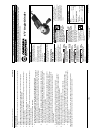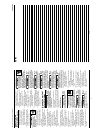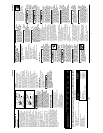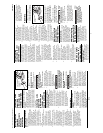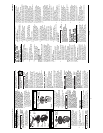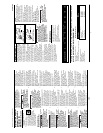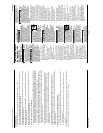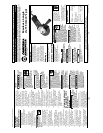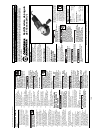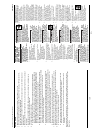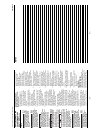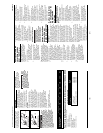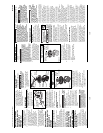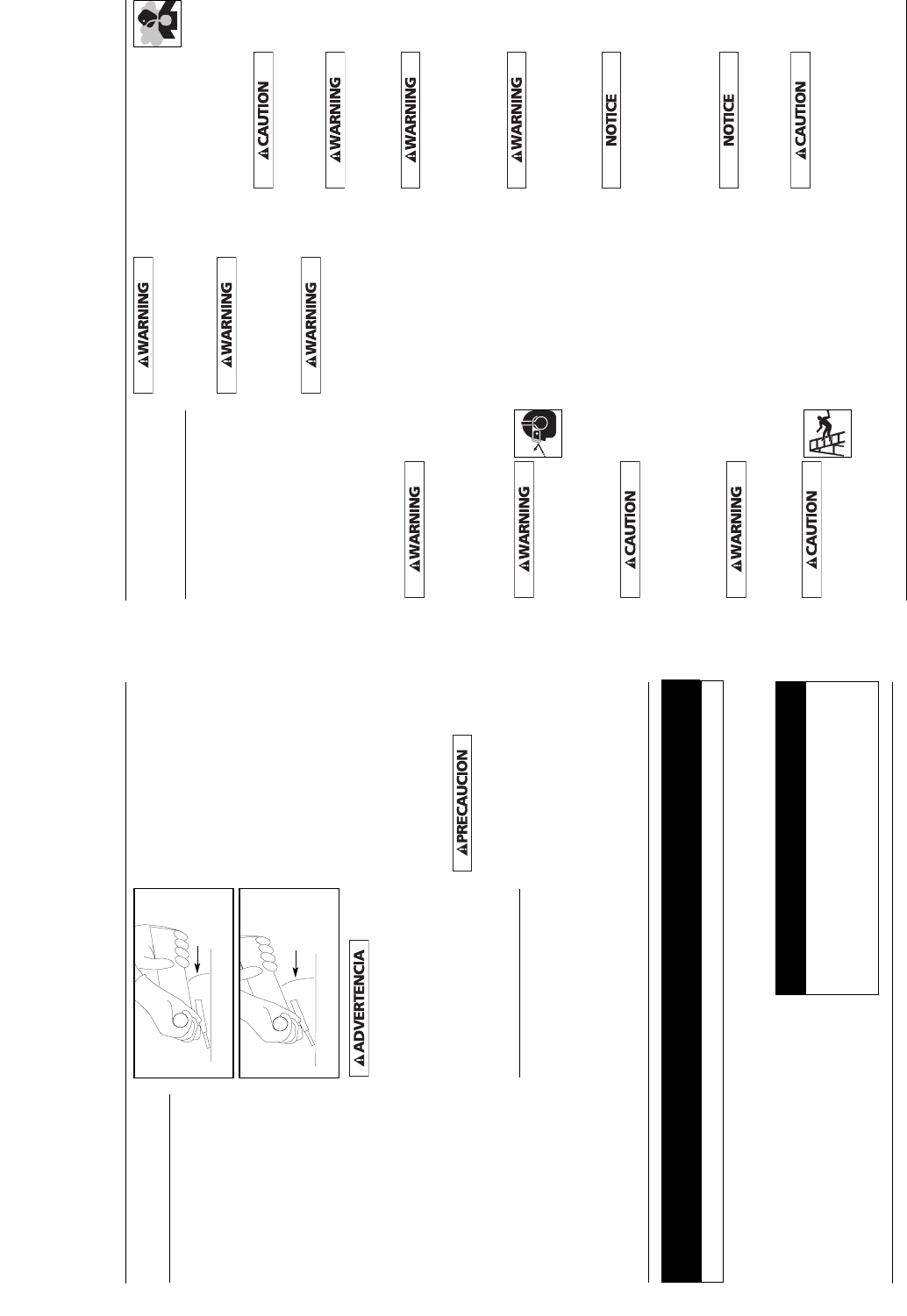
26 Sp
DG470500CK
Para Ordenar Repuestos o Asistencia Técnica, Llame al Teléfono 1-800-424-8936
Sirvase darnos la siguiente información:
- Número del modelo
- Código impreso
- Descripción y número del repuesto según la lista de repuestos
Número del
Descripción Repuesto
Dirija toda la correspondencia a:
Campbell Hausfeld
Attn: Customer Service
100 Production Drive
Harrison, OH 45030 U.S.A.
Lista de Repuestos
Disco de rectificado para metal
de 4,5" (115 mm) DG027700AV
Mango lateral DG027800AV
Llave de 2 dientes DG026600AV
Tuerca de sujeción del vástago DG028600AV
Calibre del cable 18 18 16 14 14 12 12 10 10
Cables de extensión para rectificadora de 4 1/2" (115 mm)
Longitud del cable (pies) 25 50 100 150 200 250 300 400 500
Funcionamiento
(Continuación)
alcancen la máxima velocidad.
Baje gradualmente la rectificadora
hasta que la rueda abrasiva entre en
contacto con la pieza de trabajo.
Para obtener mejores resultados
mantenga la rectificadora inclinada
a un ángulo entre 5 y 15 grados y
muévala constantemente a un ritmo
parejo (ver Figuras 5 y 6). Mueva la
rectificadora para adelante y atrás
o arriba y abajo en el área de trabajo.
Mantenga la rectificadora en
movimiento para no eliminar una
cantidad excesiva de material de una
misma área. Si mantiene la
rectificadora en un punto durante
mucho tiempo, cortará y hará ranuras
en la pieza. Si la rectificadora se
mantiene en un ángulo demasiado
agudo, también hará ranuras en la
pieza de trabajo debido a la
concentración de la presión en una
pequeña área.
Utilice apenas la presión suficiente
para evitar que la rectificadora vibre
o rebote. Demasiada presión
disminuirá la velocidad y forzará el
motor. Normalmente, sólo el peso de
la herramienta alcanza para la mayoría
de los trabajos de rectificado. Utilice
poca presión cuando rectifique bordes
mellados o pernos flojos donde existe
la posibilidad de que la rectificadora
se enganche en un borde de metal.
Aleje la rectificadora de la pieza antes
de apagarla.
General Power Tool
Safety Warnings
(Continued)
• That the pins on plug of extension
cord are the same number, size
and shape as those of plug on
tool cord.
• That the extension cord is
properly wired and in good
electrical condition.
• If an extension cord is to be used
outdoors it must be marked with
the suffix “W-A” or “W”
following the cord type
designation to indicate it is
acceptable for outdoor use. For
example – SJTW-A
5. Do not expose cord to rain, snow or
frost.
PERSONAL SAFETY
Stay
alert,
watch what you are doing and use com-
mon sense when operating a power
tool. Do not use a power tool while you
are tired or under the influence of drugs,
alcohol or medication. A moment of inat-
tention while operating power tools
may result in serious personal injury.
Use personal protective
equipment. Always wear eye
protection. Protective equip-
ment such as dust mask, non-skid safe-
ty shoes, hard hat, or hearing protec-
tion used for appropriate conditions
will reduce personal injuries.
Prevent
uninten-
tional starting. Ensure the switch is in
the off-position before connecting to
power source and/or battery pack, pick-
ing up or carrying the tool. Carrying
power tools with your finger on the
switch or energising power tools that
have the switch on invites accidents.
Remove
any
adjusting key or wrench before turning
the power tool on. A wrench or a key
left attached to a rotating part of the
power tool may result in personal injury.
Do not overreach. Keep prop-
er footing and balance at all
times. This enables better
control of the power tool in unexpect-
ed situations.
Dress
properly.
Do not wear loose clothing or jew-
ellery. Keep your hair, clothing and
gloves away from moving parts. Loose
clothes, jewellery or long hair can be
caught in moving parts.
If devices
are pro-
vided for the connection of dust
extraction and collection facilities,
ensure these are connected and proper-
ly used. Use of dust collection can
reduce dust-related hazards.
Do
not
misuse this product. Excessive
exposure to vibration, work in
awkward positions, and repetitive
work motions can cause injury to
hands and arms. Stop using any tool if
discomfort, numbness, tingling, or pain
occur, and consult a physician.
1. Wear personal protective
equipment. Depending on
application, use face shield, safety
goggles or safety glasses. As
appropriate, wear dust mask,
hearing protectors, gloves and shop
apron capable of stopping small
abrasive or workpiece fragments.
The eye protection must be capable
of stopping flying debris generated
by various operations . The dust
mask or respirator must be capable
of filtrating particles generated by
your operation. Prolonged exposure
to high intensity noise may cause
hearing loss.
2. Always work in a well-ventilated
area. Wear an OSHA-approved dust
mask and safety glasses.
3. Hold tool by insulated gripping
surface when performing an
operation where the tool may
contact hidden wiring. Contacting a
“live” wire will make exposed metal
parts of the tool “live” and shock
the operator.
4. Keep hands away from rotating
parts.
5. Use clamps or another practical way
to secure the workpiece to a stable
platform. Never hold work in your
hand, lap, or against other parts of
your body when using this tool.
6. Make sure all nails and staples are
removed from work piece before
using this tool.
7. SANDING OF LEAD BASED PAINT IS
NOT RECOMMENDED. Lead based
paint should only be removed by a
professional.
8. DO NOT INSTALL WOODCARVING
BLADE on this grinder.
9. Some wood contains
preservatives which can
be toxic. Take extra care
to prevent inhalation and
skin contact when
working with these materials.
Request, and follow, any safety
information available from your
material supplier.
POWER TOOL USE AND CARE
Do not
force the
power tool. Use the correct power tool
for your application. The correct power
tool will do the job better and safer at
the rate for which it was designed.
Do not
use the
power tool if the switch does not turn
it on and off. Any power tool that can-
not be controlled with the switch is
dangerous and must be repaired.
Disconnect the plug from the power
source and/or the battery pack from
the power tool before making any
adjustments, changing accessories, or
storing power tools. Such preventive
safety measures reduce the risk of
starting the power tool accidentally.
Store
idle
power tools out of the reach of chil-
dren and do not allow persons unfamil-
iar with the power tool or these
instructions to operate the power tool.
Power tools are dangerous in the
hands of untrained users.
Maintain
power
tools. Check for misalignment or bind-
ing of moving parts, breakage of parts
and any other condition that may
affect the power tool’s operation. If
damaged, have the power tool
repaired before use. Many accidents
are caused by poorly maintained power
tools.
Keep
cutting
tools sharp and clean. Properly main-
tained cutting tools with sharp cutting
edges are less likely to bind and are
easier to control.
Use the
power
tool, accessories and tool bits etc. in
accordance with these instructions,
taking into account the working condi-
tions and the work to be performed.
Use of the power tool for operations
different from those intended could
result in a hazardous situation.
3
www.chpower.com
DG470500CK
5° - 15°
Figura 5 - Ángulo correcto
30°+
Figura 6 - Ángulo incorrecto
Limpieza
Limpie el polvo y los desechos de
los orificios y contactos eléctricos,
soplando con aire comprimido.
Mantenga los mangos de las
herramientas limpios, secos y libres
de aceite o grasa. Use únicamente un
jabón suave y un paño húmedo para
limpiar la herramienta, evitando todos
los contactos eléctricos.
Ciertos agentes de limpieza y solventes
son nocivos para los plásticos y otras
piezas aisladas. Algunos de éstos
incluyen gasolina, aguarrás, solvente
para laca, solvente de pintura,
solventes de limpieza con cloro,
amoníaco y detergentes de uso
doméstico que contengan amoníaco.
Nunca use solventes inflamables
ni combustibles cerca de las
herramientas.
SERVICIO TÉCNICO
Para obtener información con relación
al funcionamiento o reparación de
este producto, sírvase llamar al
1-800-424-8936.
El servicio de la herramienta debe
serrealizado sólo por personal de
reparaciones calificado. El servicio o
mantenimiento realizado por personas
no calificadas puede provocar riesgo
delesiones.
En las
operaciones normales de cepillado con
alambre, el material eliminado y las
cerdas del cepillo se dispararán (hasta
50pies o más) con una fuerza
considerable. Existe la posibilidad de que
ocurran lesiones graves. Para protegerse
contra este riesgo, los operadores y
demás personas en el área de trabajo
deben usar vestimenta de protección
ygafas de seguridad, o protectores para
todo el rostro sobre lasgafas de
seguridad con protección lateral.
Mantenimiento
El servicio de la herramienta debe
ser realizado sólo por personal de
reparaciones calificado. El servicio
o mantenimiento realizado por
personas no calificadas puede provocar
riesgo de lesiones.
Si la herramienta no funciona
correctamente, devuelva la
herramienta a una instalación
de servicios para repararla.



